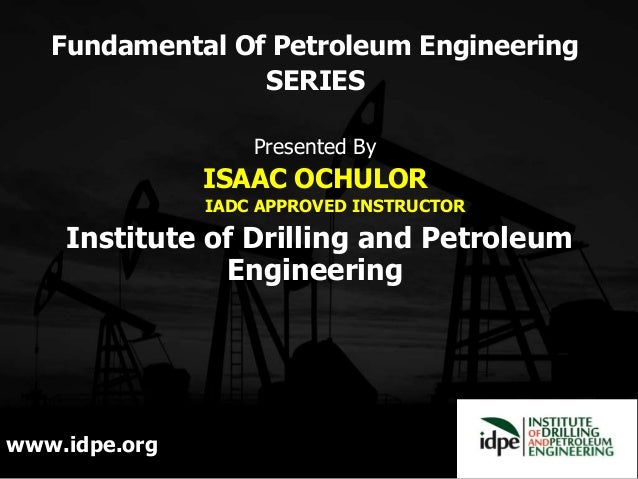Petroleum Reservoir Engineering Physical Properties Pdf Viewer
Abdus Satter, Ghulam M. Iqbal, in, 2016 IntroductionReservoir engineers play an important role in assessing and enhancing petroleum reserves. Generally speaking, petroleum reserves relate to the volumes of oil and gas that can be recovered from reservoirs technically and economically. Technical methodology must be available to produce oil and gas from the subsurface reservoir conditions. Economic considerations include profitable capital investment that factors in the cost of discovery, development, facilities, production, and transport, among others. This chapter highlights the various topics related to petroleum reserves and attempts to address the following queries:.What are the petroleum reserves? How are the reserves defined?.How are various types of oil and gas reserves distinguished from each other?.How do technological innovations, probability of occurrences, and commercial viability influence the classification of reserves?.How are unconventional petroleum reserves distinguished from conventional reserves?.What are the petroleum resources?
How are the resources categorized?.How are reserves estimated and reported for oil and gas reservoirs?.Do petroleum reserves change with time? If yes, what are the factors responsible for change?.Are there any inherent uncertainties in petroleum reserves estimation?.What are the potential sources of errors in estimating reserves? Reservoir engineers adopt various strategies in the development of low to ultralow permeability reservoirs, including the unconventional reservoirs. Some of the methods are as follows:.Infill drilling, resulting in relatively close well spacing.Horizontal drilling, single lateral or multilateral.Well stimulation by hydraulic fracturing and acidization.Reservoir management based on intensive monitoring of well performance, including the deployment of permanent downhole gauges. This leads to the evaluation of formation damage, well productivity, and reservoir performance as a whole on a regular basis.
Various aspects of horizontal well technology have been discussed in an earlier chapter. This chapter discusses infill wells that are drilled as a widely practiced strategy in the oil and gas industry. Infill wells contact the portion that was not contacted before and produce additional quantities of oil and gas.
Some of the benefits of infill drilling are:.Better reservoir economics and addition of assets as more wells are drilled in appropriate locations.Long lasting production in commercial quantities from low to ultralow permeability formations.Increased rock exposure to wellbores where severe reservoir heterogeneities exist.Increase in horizontal and vertical sweep efficiency during waterflood.Enhancement in connectivity between injectors and producers.Longer reservoir life. The following types of reservoir are best suited for the implementation of infill drilling technology:.Tight reservoirs having low to ultralow permeability.
. Provides a comprehensive view of important physicochemical phenomena and processes during oil production. Shares detailed analysis of reservoir rock and fluid properties affecting oil recovery in oil reservoir development. Offers empirical equation for estimation of physical properties of crude oil. Describes the micromechanism of fluids through porous media and irreducible oil forming in pores. Introduces up-to-date EOR methods and technologies. Richly illustrated throughout with flow charts to help understand physical/chemical phenomena and processes.

This book introduces in detail the physical and chemical phenomena and processes during petroleum production. It covers the properties of reservoir rocks and fluids, the related methods of determining these properties, the phase behavior of hydrocarbon mixtures, the microscopic mechanism of fluids flowing through reservoir rocks, and the primary theories and methods of enhancing oil recovery. It also involves the up-to-date progress in these areas. It can be used as a reference by researchers and engineers in petroleum engineering and a textbook for students majoring in the area related with petroleum exploitation. Xuetao Hu holds a Ph.D.

Degree in Oil & Gas Development Engineering from Southwest Petroleum University (SWPU). She is a professor at the School of Oil & Natural Gas Engineering in SWPU with nearly 20 years’ experience of teaching and researching in the fields of physical properties of petroleum reservoir rocks and fluids, oil & gas development geology and engineering. During these years, Prof. Hu has been responsible for more than 40 research projects, including several national key projects. She was awarded the National Prize for Progress in Science and Technology, 2 Teaching Achievement Prizes from the Ministry of Education of P.R.C and 8 Teaching Achievement Prizes from SWPU.
She is the author of more than 40 articles in academic journals on petroleum geology and engineering, including 4 SCI and 1 EI indexed. Besides, she edited 3 textbooks published by the Petroleum Industry Press.Publications:(1) Xuetao Hu, Jian-Yi Liu, Chun-Sheng Jia. The 3(3)Sigma(+)(g) state of Cs-2 molecule. Computational and Theoretical Chemistry. 2013(1019): 137-140(2) Xuetao Hu, Lie-Hui Zhang, Chun-Sheng Jia. D-dimensional energies for lithium dimer.
Journal of Molecular Spectroscopy. 2014, 297 (1): 21(3) Xuetao Hu, Lie-Hui Zhang, Chun-Sheng Jia. D-dimensional energies for cesium and sodium dimmers.
Canadian Journal of Chemistry. 2014, 92 (5): 386-391(4) Xuetao Hu, Luo Qiang,Ran Zengling. First principles calculation on adsorption of S on Fe(100) with different pressure. Applied Mechanics and Materials. 2012(217-219):1811-1814(5) Xuetao Hu. Special textbooks of petroleum colleges and universities: Physics of Petroleum Reservoirs. Petroleum Industry Press, 2013.1(6) Edited Chapter 1 of the “FYP11” national planning textbooks: Oil and Gas Fluid Mechanics in Underground Porous Media.
Petroleum Reservoir Engineering Physical Properties Pdf Viewer Pdf
Petroleum Industry Press, 2007,12(7) Edited Chapter 2 of the “FYP11” national planning textbooks: Development Plan Design of Gas Fields. Petroleum Industry Press, 2006.5Fayang Jin, Ph.D of Oil & Gas Development Engineering from Southwest Petroleum University (SWPU), is an associate professor at the School of Oil & Natural Gas Engineering in SWPU. He mainly devotes himself to the area of EOR techniques: profile control, water shutoff and chemical flooding.
He has been charged of many programs in EOR field including the subproject of Key national Science and Technology Project. Book Title Physics of Petroleum Reservoirs Editors. Xuetao Hu. Shuyong Hu. Fayang Jin. Su HuangSeries Title Copyright 2017 Publisher Springer-Verlag Berlin Heidelberg Copyright Holder Petroleum Industry Press and Springer-Verlag Berlin Heidelberg eBook ISBN 978-3-662-55026-7 DOI 10.1007/978-3-662-55026-7 Hardcover ISBN 978-3-662-55025-0 Softcover ISBN 978-3-662-57220-7 Series ISSN 2364-9119 Edition Number 2 Number of Pages IX, 506 Number of Illustrations 290 b/w illustrations Additional Information Jointly published with Petroleum Industry Press, Beijing, China Topics.